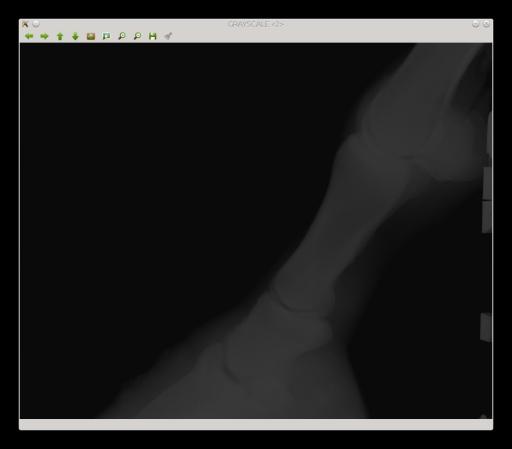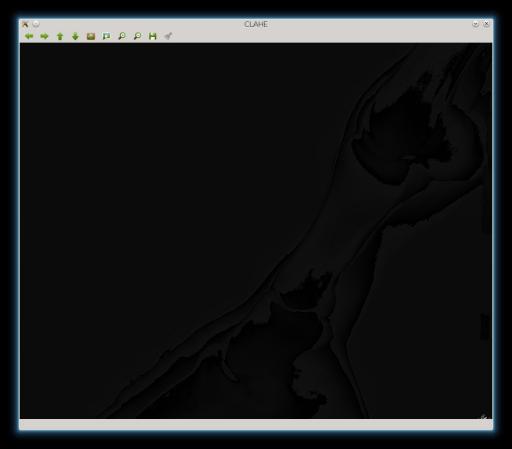OpenCV 3.0 CLAHE with 16bit images
Hello,
I'm trying to use the openCV CLAHE implementation on 16 bits medical images and the results are not what I expected, it looks like the algorithm overlflows, resulting in a very dark image. If I convert the original image to CV_8U using cv::Mat:: convertTo() with an alpha value = 1.0 / (1 << (BitsStored - 8)), this is because images are really 10 or 12 bit unsigned int images, the result is correct and what I expect, see the examples below.
Original image

8 bits CLAHE

16 bits CLAHE

The code is very simpe
int main(int argc, char *argv[])
{
QApplication a(argc, argv);
// Load DICOM Image
DcmObject raw;
if( !raw.load("rawimage.dcm") )
qCritical(qPrintable(QString("Error loading rawimage.dcm: %1").arg(raw.errorString())));
// Convert to cv::Mat, internally can covert to 8 bit if wanted
cv::Mat mat = dcmImageToCvMat(DcmImage(raw));
cv::imshow("GRAYSCALE", mat);
cv::Ptr<cv::CLAHE> clahe = cv::createCLAHE(3.0, cv::Size(8,8));
cv::Mat dst;
clahe->apply(mat, dst);
cv::imshow("CLAHE", dst);
cv::waitKey();
}
Below is the code I use to convert from DICOM to cv::Mat:, it uses a dicom toolkit written by me:
cv::Mat dcmImageToCvMat(const DcmImage &img, bool convertTo8Bits)
{
cv::Mat mat;
switch( img.pixelRepresentation() )
{
case DcmImage::PixelUInt8:
mat = cv::Mat(img.rows(), img.columns(), CV_8U);
break;
case DcmImage::PixelInt8:
mat = cv::Mat(img.rows(), img.columns(), CV_8S);
break;
case DcmImage::PixelUInt16:
mat = cv::Mat(img.rows(), img.columns(), CV_16U);
break;
case DcmImage::PixelInt16:
mat = cv::Mat(img.rows(), img.columns(), CV_16S);
break;
case DcmImage::PixelInt32:
case DcmImage::PixelUInt32:
mat =cv::Mat(img.rows(), img.columns(), CV_32S);
break;
}
// Get RAW Pixel data
img.raw(mat.data, 0, 0, img.columns(), img.rows(), mat.step);
// Invert if Photometric interpretation is MONOCHROME1 (white is 0)
if( img.photometricInterpretation()==DcmImage::PmiMonochrome1 )
{
cv::Mat max(mat.size(), mat.type());
max.setTo(img.maxPossibleValue());
mat = max - mat;
}
// Convert to CV_16U with correct scaling of values
switch( img.pixelRepresentation() )
{
case DcmImage::PixelInt8:
mat.convertTo(mat, CV_8U, 1.0, -img.minPossibleValue());
break;
case DcmImage::PixelInt16:
mat.convertTo(mat, CV_16U, 1.0, -img.minPossibleValue());
break;
case DcmImage::PixelInt32:
case DcmImage::PixelUInt32:
mat.convertTo(mat, CV_16U, 1.0 / double(1 << (img.bitsStored() - 16)), -img.minPossibleValue());
break;
}
// Converts to 8 bits if wanted
if( convertTo8Bits )
{
cv::Mat mat8;
float scale = 1 << (img.bitsStored() - 8);
float shift = img.isSigned() ? 127.0 : 0.0;
cv::convertScaleAbs(mat, mat8, 1.0 / scale, shift);
return mat8;
}
else
return mat;
}
Thank you very much,
Gianluca Ghelli

unfortunately, your images are all 8bit jpegs. can you at least upload your 16bit one somewhere (as png or tif), so folks here can actually try things with it ?
I'm sorry I didn't answer before. You can find a 16 bit png image at the following link:
link raw16.png
Thank you
did it have to be that huge ? ;(
:), that's the kind of image we use, for mammographies it's also more than double that size! If you want I can resize it.